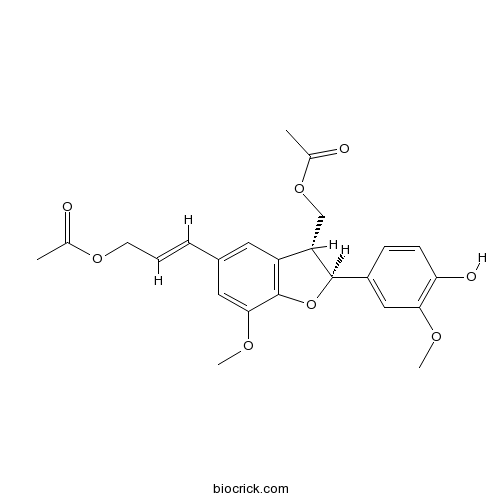Dimeric coniferyl acetateCAS# 184046-40-0 |

Quality Control & MSDS
3D structure
Package In Stock
Number of papers citing our products

| Cas No. | 184046-40-0 | SDF | Download SDF |
| PubChem ID | 44584272 | Appearance | Powder |
| Formula | C24H26O8 | M.Wt | 442.5 |
| Type of Compound | Lignans | Storage | Desiccate at -20°C |
| Solubility | Soluble in Chloroform,Dichloromethane,Ethyl Acetate,DMSO,Acetone,etc. | ||
| Chemical Name | [(E)-3-[(2S,3R)-3-(acetyloxymethyl)-2-(4-hydroxy-3-methoxyphenyl)-7-methoxy-2,3-dihydro-1-benzofuran-5-yl]prop-2-enyl] acetate | ||
| SMILES | CC(=O)OCC=CC1=CC2=C(C(=C1)OC)OC(C2COC(=O)C)C3=CC(=C(C=C3)O)OC | ||
| Standard InChIKey | TYXVTGSQLKCKCF-FDTLDTTQSA-N | ||
| Standard InChI | InChI=1S/C24H26O8/c1-14(25)30-9-5-6-16-10-18-19(13-31-15(2)26)23(32-24(18)22(11-16)29-4)17-7-8-20(27)21(12-17)28-3/h5-8,10-12,19,23,27H,9,13H2,1-4H3/b6-5+/t19-,23+/m0/s1 | ||
| General tips | For obtaining a higher solubility , please warm the tube at 37 ℃ and shake it in the ultrasonic bath for a while.Stock solution can be stored below -20℃ for several months. We recommend that you prepare and use the solution on the same day. However, if the test schedule requires, the stock solutions can be prepared in advance, and the stock solution must be sealed and stored below -20℃. In general, the stock solution can be kept for several months. Before use, we recommend that you leave the vial at room temperature for at least an hour before opening it. |
||
| About Packaging | 1. The packaging of the product may be reversed during transportation, cause the high purity compounds to adhere to the neck or cap of the vial.Take the vail out of its packaging and shake gently until the compounds fall to the bottom of the vial. 2. For liquid products, please centrifuge at 500xg to gather the liquid to the bottom of the vial. 3. Try to avoid loss or contamination during the experiment. |
||
| Shipping Condition | Packaging according to customer requirements(5mg, 10mg, 20mg and more). Ship via FedEx, DHL, UPS, EMS or other couriers with RT, or blue ice upon request. | ||
| Description | 1. Dimeric coniferyl acetate shows strong NO inhibition with IC50 values of 27.1 uM in lipopolysacchalide (LPS)-activated murine macrophage-like J774.1 cells. 2. Dimeric coniferyl acetate exhibits significant inhibitory effects on the nitric oxide production in lipopolysaccharide activated C57BL6/J mouse macrophages. |
| Targets | NO |

Dimeric coniferyl acetate Dilution Calculator

Dimeric coniferyl acetate Molarity Calculator
| 1 mg | 5 mg | 10 mg | 20 mg | 25 mg | |
| 1 mM | 2.2599 mL | 11.2994 mL | 22.5989 mL | 45.1977 mL | 56.4972 mL |
| 5 mM | 0.452 mL | 2.2599 mL | 4.5198 mL | 9.0395 mL | 11.2994 mL |
| 10 mM | 0.226 mL | 1.1299 mL | 2.2599 mL | 4.5198 mL | 5.6497 mL |
| 50 mM | 0.0452 mL | 0.226 mL | 0.452 mL | 0.904 mL | 1.1299 mL |
| 100 mM | 0.0226 mL | 0.113 mL | 0.226 mL | 0.452 mL | 0.565 mL |
| * Note: If you are in the process of experiment, it's necessary to make the dilution ratios of the samples. The dilution data above is only for reference. Normally, it's can get a better solubility within lower of Concentrations. | |||||

Calcutta University

University of Minnesota

University of Maryland School of Medicine

University of Illinois at Chicago

The Ohio State University

University of Zurich

Harvard University

Colorado State University

Auburn University

Yale University

Worcester Polytechnic Institute

Washington State University

Stanford University

University of Leipzig

Universidade da Beira Interior

The Institute of Cancer Research

Heidelberg University

University of Amsterdam

University of Auckland

TsingHua University

The University of Michigan

Miami University

DRURY University

Jilin University

Fudan University

Wuhan University

Sun Yat-sen University

Universite de Paris

Deemed University

Auckland University

The University of Tokyo

Korea University
- sitaxsentan
Catalog No.:BCC1951
CAS No.:184036-34-8
- Ciproxifan maleate
Catalog No.:BCC4049
CAS No.:184025-19-2
- Ciproxifan
Catalog No.:BCC4539
CAS No.:184025-18-1
- Mithramycin A
Catalog No.:BCC2470
CAS No.:18378-89-7
- Cyanidin 3-sophoroside chloride
Catalog No.:BCN2611
CAS No.:18376-31-3
- Amyloid β-Protein (1-15)
Catalog No.:BCC1003
CAS No.:183745-81-5
- MRS 1220
Catalog No.:BCC6972
CAS No.:183721-15-5
- 1,2,3,4,5,6-Hexabromocyclohexane
Catalog No.:BCC2437
CAS No.:1837-91-8
- Penthiopyrad
Catalog No.:BCC8072
CAS No.:183675-82-3
- CYN 154806
Catalog No.:BCC5823
CAS No.:183658-72-2
- Cleroindicin A
Catalog No.:BCC8916
CAS No.:176598-06-4
- Apicidin
Catalog No.:BCC3599
CAS No.:183506-66-3
- Calystegine B4
Catalog No.:BCN1881
CAS No.:184046-85-3
- Isoleojaponin
Catalog No.:BCN7442
CAS No.:1840966-49-5
- Hautriwaic acid
Catalog No.:BCN4686
CAS No.:18411-75-1
- GB 2a
Catalog No.:BCN7425
CAS No.:18412-96-9
- SR 142948
Catalog No.:BCC7323
CAS No.:184162-64-9
- Dihydromorin
Catalog No.:BCN1149
CAS No.:18422-83-8
- Picfeltarraenin IV
Catalog No.:BCN2852
CAS No.:184288-35-5
- Vitisin B
Catalog No.:BCN6697
CAS No.:142449-90-9
- Cucurbitacin E
Catalog No.:BCN2300
CAS No.:18444-66-1
- Gefitinib
Catalog No.:BCN2173
CAS No.:184475-35-2
- Gefitinib hydrochloride
Catalog No.:BCC1591
CAS No.:184475-55-6
- Madecassic acid
Catalog No.:BCN1013
CAS No.:18449-41-7
Five new compounds from Rhododendron mariae Hance.[Pubmed:24320934]
J Asian Nat Prod Res. 2014 Jan;16(1):1-10.
Five new compounds (-)-(7R,8S,7'R,8'S)-4,9,4',9'-tetrahydroxy-3,3'-dimethoxy-7,7'-epoxylignan 9-O-beta-d-xylopyranoside (1), (-)-(7'R,8'S)-5'-methoxyl(Dimeric coniferyl acetate) (2), (+)-(1R,2S)-1,2-bis(4-hydroxy-3-methoxyphenyl)-3-acetyl-1,3-propanediol (3), (-)-3-((2R,3R)-2-ethoxy-3-(hydroxymethyl)-7-methoxy-2,3-dihydrobenzofuran-5-yl)pr opan-1-ol (4), and (+)-3-((2S,3S)-2-ethoxy-3-(hydroxymethyl)-7-methoxy-2,3-dihydrobenzofuran-5-yl)pr opan-1-ol (5), together with 12 known compounds, were isolated from an ethanol extract of the dried stems of Rhododendron mariae Hance. Their structures were elucidated by NMR, HR-MS, CD, ORD experiments and chemical methods. Compounds 2, 3, 6, and 17 exhibited significant inhibitory effects on the nitric oxide production in lipopolysaccharide activated C57BL6/J mouse macrophages.


